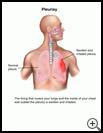
Pleurisy
________________________________________________________________________
KEY POINTS
- Pleurisy is when the lining that covers your lungs and the inside of your chest wall is swollen and irritated. It may because of an infection, injury, blood clot, or disease.
- Treatment depends on the cause of your pleurisy. Your healthcare provider may prescribe medicines to help you breathe, or to treat blood clots, infection, or pain. You may need to stay in the hospital.
- Follow the full course of treatment prescribed by your healthcare provider. Ask your provider how long it will take to recover and how to take care of yourself at home.
________________________________________________________________________
What is pleurisy?
Pleurisy is when the lining that covers your lungs and the inside of your chest wall is swollen and irritated. This lining is called the pleura. Pleurisy is also called pleuritis.
What is the cause?
Pleurisy may happen when:
- You have a lung infection, such as a cold, flu, pneumonia, or tuberculosis.
- Your chest is injured.
- Part or all of one of your lungs collapses (a pneumothorax).
- You have a blood clot in a lung.
- You have diseases such as sickle cell, arthritis, heart failure, liver disease, or cancer.
- You have chest or heart surgery.
You are at greater risk of having pleurisy if you smoke.
What are the symptoms?
Symptoms may include:
- Sudden, sharp chest pain when you breathe especially when you take deep breaths, cough, sneeze, or laugh
- Pain that gets better or goes away between breaths
- Feeling short of breath
- Fever
Sometimes pleurisy causes a lot of swelling, and fluid collects in the space between your lungs and your ribcage (pleural space). This collection of fluid is called a pleural effusion, and the symptoms are the same as pleurisy. The fluid buildup makes it hard for your lungs to expand when you breathe. If you can't breathe normally, your body may not get enough oxygen to work properly. The fluid may need to be removed in the hospital.
How is it diagnosed?
Your healthcare provider will ask about your symptoms and medical history and examine you. Using a stethoscope on your chest, your provider will listen for a rubbing sound when you breathe. You may have these tests:
- Chest X-ray
- Blood tests
How is it treated?
Treatment depends on the cause of your pleurisy and how serious your symptoms are. If you are having trouble breathing, your healthcare provider may recommend removing the fluid from around your lungs (thoracentesis):
If there is no fluid problem, you provider may prescribe:
- Medicine for the pain and inflammation
- Medicine that you inhale to help open the airways so you can breathe more easily
- Antibiotic medicine if you have a bacterial infection
- Medicines to treat blood clots
You may need to stay in the hospital for treatment if you have had a chest injury or collapsed lung.
How can I take care of myself?
Follow the full course of treatment prescribed by your healthcare provider. In addition:
- If you are taking antibiotic medicine, take the medicine for as long as your healthcare provider prescribes, even if you feel better. If you stop taking the medicine too soon, you may not kill all of the bacteria and you may get sick again.
- It is very important to breathe deeply several times an hour when you have pleurisy. When you don't breathe deeply, the lower parts of your lungs can collapse, and increase your risk for pneumonia.
- Don’t smoke, and stay away from others who are smoking.
- Avoid breathing dust and chemical fumes.
- Ask your provider about taking aspirin, ibuprofen, or acetaminophen for fever or chest pain. Read the label and take as directed. Unless recommended by your healthcare provider, you should not take these medicines for more than 10 days.
- Nonsteroidal anti-inflammatory medicines (NSAIDs), such as ibuprofen, naproxen, and aspirin, may cause stomach bleeding and other problems. These risks increase with age.
- Acetaminophen may cause liver damage or other problems. Unless recommended by your provider, don't take more than 3000 milligrams (mg) in 24 hours. To make sure you don’t take too much, check other medicines you take to see if they also contain acetaminophen. Ask your provider if you need to avoid drinking alcohol while taking this medicine.
Ask your provider:
- How and when you will get your test results
- How long it will take to recover
- If there are activities you should avoid and when you can return to your normal activities
- How to take care of yourself at home
- What symptoms or problems you should watch for and what to do if you have them
Make sure you know when you should come back for a checkup. Keep all appointments for provider visits or tests.

